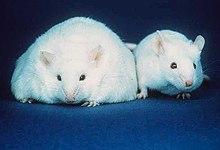The ob/ob or obese mouse is a mutant mouse that eats excessively due to mutations in the gene responsible for the production of leptin and becomes profoundly obese. It is an animal model of type II diabetes. Identification of the gene mutated in ob led to the discovery of the hormone leptin, which is important in the control of appetite.

The first ob/ob mouse arose by chance in a colony at the Jackson Laboratory in 1949.[1] The mutation is recessive. Mutant mice are phenotypically indistinguishable from their unaffected littermates at birth, but gain weight rapidly throughout their lives, reaching a weight three times that of unaffected mice. ob/ob mice develop high blood sugar, despite an enlargement of the pancreatic islets and increased levels of insulin.[2]
The gene affected by the ob mutation was identified by positional cloning.[3] The gene produces a hormone, called leptin, that is produced predominantly in adipose tissue. One role of leptin is to regulate appetite by signalling to the brain that the animal has had enough to eat.[4] Since the ob/ob mouse cannot produce leptin, its food intake is uncontrolled by this mechanism.
A positional cloning approach in the Lepob mouse allows to identify the locus of the gene encoding for the ob protein. Clones were used to construct a contig across most of the 650-kb critical region of ob. Exons from this interval were trapped using exon trapping method and each was afterward sequenced and searched in the GenBank. One of the exons was hybridized to a Northern blot of mouse white adipose tissue (WAT). This allowed to investigate the levels of ob gene expression which seemed to be markedly increased in WAT of Lepob mice. This is consistent with a biologically inactive truncated protein.[3]
See also
editReferences
edit- ^ Ingalls AM, Dickie MM, Snell GD (December 2022). "Obese, a new mutation in the house mouse". J. Hered. 41 (12): 317–8. doi:10.1093/oxfordjournals.jhered.a106073. PMID 14824537.
- ^ Lindström P (2007). "The physiology of obese-hyperglycemic mice [ob/ob mice]". ScientificWorldJournal. 7: 666–85. doi:10.1100/tsw.2007.117. PMC 5901356. PMID 17619751.
- ^ a b Zhang Y, Proenca R, Maffei M, Barone M, Leopold L, Friedman JM (December 1994). "Positional cloning of the mouse obese gene and its human homologue". Nature. 372 (6505): 425–32. Bibcode:1994Natur.372..425Z. doi:10.1038/372425a0. PMID 7984236. S2CID 4359725.
- ^ Friedman JM, Halaas JL (October 1998). "Leptin and the regulation of body weight in mammals". Nature. 395 (6704): 763–70. Bibcode:1998Natur.395..763F. doi:10.1038/27376. PMID 9796811. S2CID 204997852.